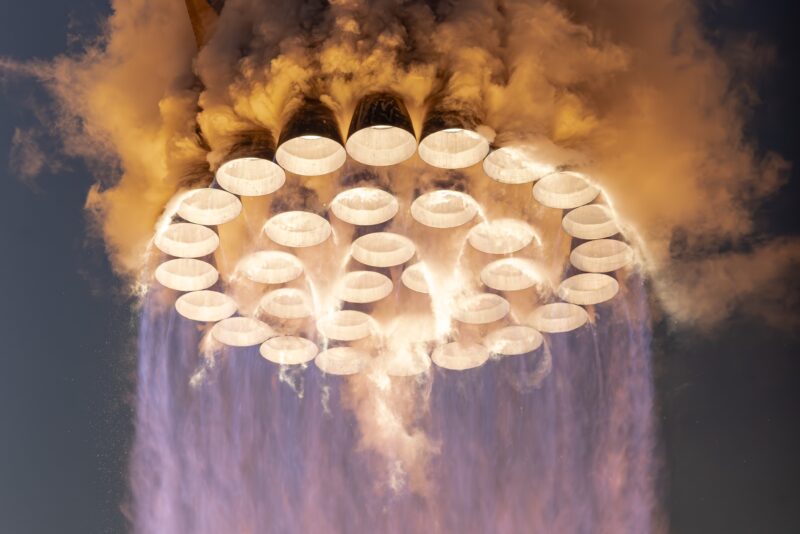SpaceX Makes Progress With Starship’s Second Test Flight

All 33 of the Super Heavy booster Raptor engines ignited in the Nov. 18 Starship flight test. Photo: SpaceX
SpaceX conducted the second Starship test flight over the weekend, making progress over the first test in April, but falling short of reaching orbit.
The test took place on Saturday morning, Nov. 18, from Starbase in Boca Chica, Texas. Flight two achieved substantial progress over the first test in April, which exploded before stage separation and reached an altitude of about 39 km. In the second test, all 33 Raptor engines successfully ignited on the Super Heavy first stage; the Starship second stage survived separation; and the flight reached a height of around 150 kilometers.
In addition, the new launch pad survived the test as well. SpaceX Founder Elon Musk shared photos of the pad after launch, reporting that no refurbishment is needed for the water-cooled steel plate before the next launch.
SpaceX is using a stage separation method for Starship called “hot staging” in which the Starship second stage engines ignite and push the spacecraft away from the Super Heavy booster. In Saturday’s test, the six Raptor engines on Starship successfully ignited and the vehicle survived hot staging. Super Heavy, however, exploded after separation.
Starship continued ascending for a few more minutes, as all six engines continued to fire. SpaceX reported that Starship climbed to an altitude of about 150 kilometers. SpaceX lost connection with Starship around nine minutes into the mission and then activated the flight termination system.
Siva Bharadvaj, space operations engineer, said on the webcast that the primary objective for Starship was to survive stage separation and continue on the path to orbit, which the vehicle achieved.
Read more: Prepare for a Space Economy that Can Leverage Starship
Musk reported that hardware for the third Starship flight should be ready in three to four weeks, as three ships are in the final stages of production.
Yet SpaceX will have to go through another mishap investigation with the Federal Aviation Administration (FAA) before it can return to flight. The FAA confirmed in a statement that the mission triggered a mishap investigation because the vehicle was lost. The FAA said no injuries or public property damage has been reported.
“A return to flight of the Starship Super Heavy vehicle is based on the FAA determining that any system, process, or procedure related to the mishap does not affect public safety. In addition, SpaceX must submit a request to modify its license to add flights,” the FAA said.
The FAA had to complete a mishap investigation, safety review, and license modification after the first test before SpaceX was cleared to launch again.
SpaceX stressed in a statement that the mission was a test and delivered valuable data.
“While it didn’t happen in a lab or on a test stand, it was absolutely a test. What we did today will provide invaluable data to continue rapidly developing Starship. With a test like this, success comes from what we learn, and today’s test will help us improve Starship’s reliability as SpaceX seeks to make life multiplanetary,” SpaceX said in a statement.
NASA Administrator Bill Nelson applauded SpaceX’s progress. NASA is counting on Starship and has awarded SpaceX billions of dollars in contracts for the vehicle to take astronauts to the Moon in its Artemis program.
“Congrats to the teams who made progress on today’s flight test. Spaceflight is a bold adventure demanding a can-do spirit and daring innovation. Today’s test is an opportunity to learn — then fly again. Together NASA and SpaceX will return humanity to the Moon, Mars & beyond,” Nelson tweeted.